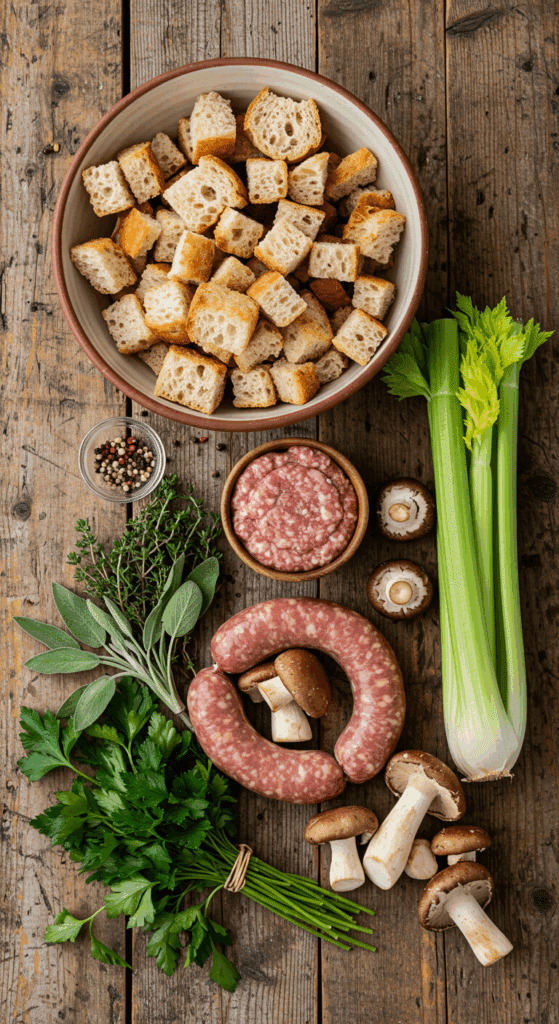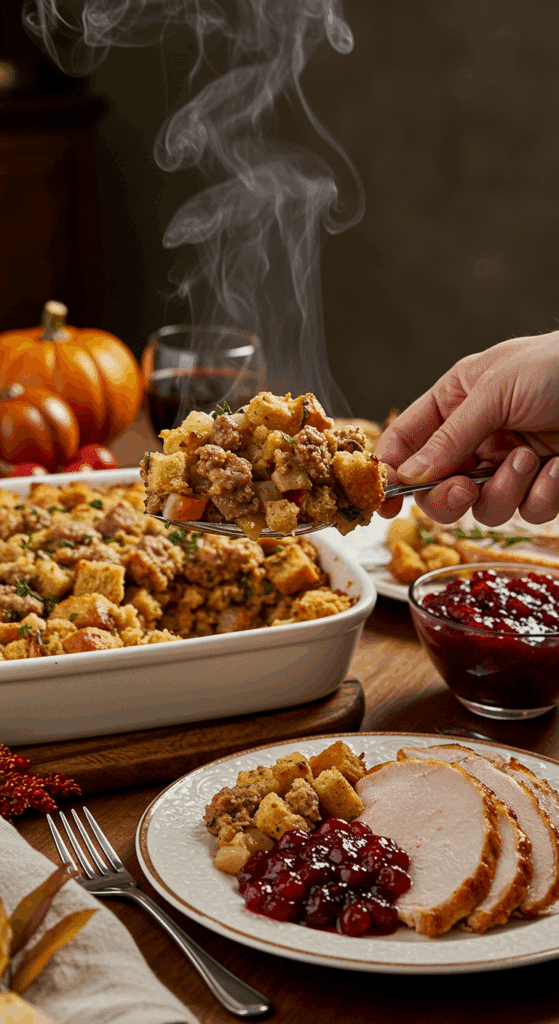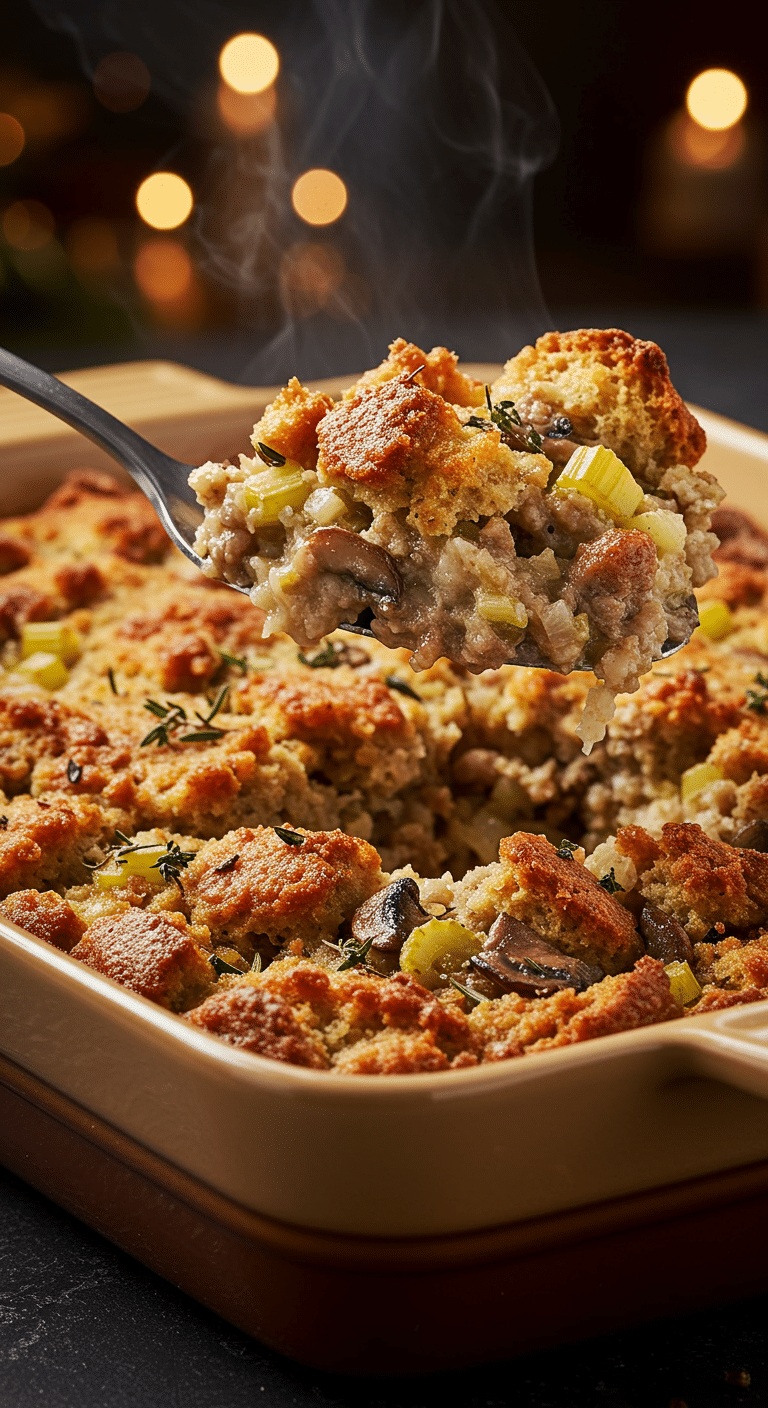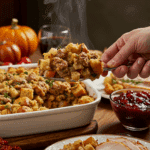Let’s be honest: for many of us, the Thanksgiving feast is really all about one iconic, soul-satisfying dish. The one dish that is the undisputed star of the side table. The one dish that everyone goes back for seconds of. We’re talking, of course, about the stuffing. And this incredible, from-scratch Sausage and Herb Stuffing, loaded with savory sausage, earthy wild mushrooms, and fresh herbs, is the perfect, crowd-pleasing recipe to grace your holiday table.
This isn’t just a recipe; it’s your complete guide to creating the most flavorful, perfectly textured stuffing you’ve ever made. Forget the boxed mixes forever. We’ll show you how to build deep, savory, restaurant-quality flavor by browning sausage, sautéing a medley of mushrooms and vegetables, and deglazing the pan with a splash of white wine. The result is a stuffing that is beautifully moist and tender on the inside with an irresistibly crisp, golden-brown top.
Table of Contents
Table of Contents
Recipe Overview: The Star of the Holiday Side Dishes
What makes this Sausage and Herb Stuffing truly the “best ever” is its incredible depth of savory flavor and its perfect, moist-but-not-soggy texture. This recipe uses classic, from-scratch techniques to build flavor at every step. Browning the sausage and mushrooms properly, deglazing the pan with wine to capture every last delicious bit, and using a rich chicken broth ensures a result that is anything but bland. Best of all, it’s a fantastic make-ahead dish, which is an absolute lifesaver for a busy Thanksgiving cook.
| Metric | Time / Level |
| Total Time | 2 hours |
| Active Prep Time | 35 minutes |
| Difficulty Level | Easy |
| Servings | 12 |
The Essential Ingredients for the Best Stuffing
This recipe uses a handful of classic, high-quality ingredients to create its signature comforting and festive flavor.
- The Bread: This is the most crucial element for the perfect stuffing texture. You must use a sturdy, crusty, day-old white bread, like a country loaf or sourdough.
- Why Day-Old?: Fresh, soft bread will turn into a soggy, mushy paste when you add the liquid. Bread that is a day or two old is drier and has a stronger structure, which allows it to act like a sponge and soak up all the delicious broth and flavors while still maintaining some of its texture. The recipe includes a quick toasting step to ensure your bread is perfectly dry.
- The Sausage & Wild Mushrooms: This is the savory, earthy heart of our stuffing.
- Sweet Italian Sausage: A pound of bulk sweet Italian sausage provides a wonderful, savory, and slightly sweet flavor base. The delicious rendered fat from the sausage is also used to sauté the vegetables, adding another layer of incredible flavor.
- Assorted Wild Mushrooms: Using a mix of mushrooms creates a deep, earthy, umami flavor. A combination of readily available varieties like cremini (baby bella), shiitake, and oyster mushrooms is a fantastic choice.
- The Flavorful Liquids:
- Dry White Wine: This is a professional touch that takes the flavor to the next level. A splash of a dry white wine (like a Sauvignon Blanc or Pinot Grigio) is used to deglaze the pan, lifting all the flavorful browned bits from the bottom and adding a bright, acidic complexity to the dish.
- Turkey or Chicken Broth: Provides the moisture and a savory, rich flavor to bind everything together. A low-sodium variety allows you to control the final saltiness of the dish.
- Fresh Herbs: It is essential to use fresh herbs for the best, most vibrant flavor. The classic stuffing trio of sage, thyme, and parsley provides that unmistakable, nostalgic “Thanksgiving” aroma and flavor.

Step-by-Step to the Perfect Holiday Stuffing
Follow these simple, detailed steps to create this stunning and delicious side dish.
Step 1: Prepare the Bread and Cook the Sausage
First, preheat your oven to 375°F (190°C). Generously butter a 9×13-inch baking dish.
If your bread is not day-old, you can dry it out. Place the 16 cups of 1-inch bread cubes in a single layer on a sheet pan and bake in a 300°F oven for 7-10 minutes, until the bread feels dry and lightly toasted. Transfer the bread cubes to a very large mixing bowl.
In a large Dutch oven or a heavy-bottomed skillet over medium heat, heat the 1 tablespoon of olive oil. Add the Italian sausage and cook, breaking it up with a wooden spoon into small crumbles, until it is nicely browned, which should take about 5 minutes. Use a slotted spoon to transfer the cooked sausage to the large bowl with the bread cubes.
Step 2: Build the Flavor Base (Deglaze & Cook the Veggies)
Add the 1/2 cup of dry white wine to the hot skillet and let it bubble, using a wooden spoon to scrape up any delicious browned bits from the bottom of the pan. Let the wine cook until it has almost completely evaporated.
Add 1 tablespoon of the butter to the skillet. Once it’s melted, add the sliced mushrooms. Season with 1 teaspoon of salt and some pepper. Cook, stirring occasionally, for about 5 minutes, until the mushrooms have browned and have cooked down to about half their original volume. Use a slotted spoon to transfer the cooked mushrooms to the bowl with the sausage and bread.
Melt the remaining 7 tablespoons of butter in the skillet. Add the diced celery, the diced onions, the minced fresh sage, and the minced fresh thyme. Cook for about 5 minutes, until the vegetables have softened.
Pour in the 4 cups of broth, bring the mixture to a simmer, and turn off the heat.
Step 3: Assemble the Stuffing and Bake to Perfection
In another large bowl (or the same one as the bread if it’s big enough), beat the 2 large eggs with the 1/4 cup of chopped fresh parsley. Add the bread cubes, the reserved sausage, and the mushrooms, and toss everything together.
Carefully pour the hot vegetable and broth mixture from the skillet over the bread mixture. Toss again until all the bread is evenly and thoroughly coated.
Transfer the entire stuffing mixture to your prepared 9×13-inch baking dish and cover it with foil.
Bake for 30 minutes. Then, remove the foil and continue to bake, uncovered, for about 30 minutes more, until the top is a beautiful deep golden brown and crispy, and the stuffing is hot all the way through.
Garnish with celery leaves or a little extra fresh parsley before serving.

The Ultimate Homemade Thanksgiving Stuffing (Best Ever!)
A classic and hearty recipe for sausage and herb stuffing, perfect for a holiday meal. This dish is made with cubes of stale white bread, which are tossed with browned sweet Italian sausage, sautéed wild mushrooms, celery, and onions. The stuffing is moistened with a savory mixture of chicken or turkey broth and eggs, and flavored with fresh herbs like sage, thyme, and parsley. It is baked in a large dish, first covered to steam and then uncovered to create a golden, crispy top.
- Prep Time: 40 minutes
- Cook Time: 1 hour 15 minutes
- Total Time: 1 hour 55 minutes
- Yield: 10-12 servings
- Category: Side Dish
- Method: Baking, Sautéing
- Cuisine: American
Ingredients
- 1 stick (8 tablespoons) unsalted butter, plus more for greasing
- 1 tablespoon olive oil
- 1 pound sweet Italian sausage, casings removed
- 1/2 cup dry white wine
- 1 pound assorted wild mushrooms, trimmed and sliced
- Kosher salt and freshly ground black pepper
- 3 stalks celery, diced
- 1 large yellow onion, diced
- 5 sage leaves, minced (about 2 tablespoons)
- 5 sprigs thyme leaves, minced (about 2 tablespoons)
- 4 cups turkey or chicken broth
- 2 large eggs
- 1/4 cup flat-leaf parsley leaves, chopped
- 16 cups cubed stale white bread
- Celery leaves for garnish (optional)
Instructions
- Preheat the oven to 375°F. Butter a 9-by-13-inch baking dish.
- Heat the olive oil in a large skillet over medium heat. Add the sausage and cook, breaking it up with a spoon, for about 5 minutes until browned. Transfer the sausage to a large bowl with a slotted spoon.
- Add the white wine to the skillet and cook for about 2 minutes, scraping up any browned bits, until the liquid has almost evaporated.
- Add 1 tablespoon of butter to the skillet, then add the mushrooms. Season with 1 teaspoon of salt and some pepper. Cook for about 5 minutes, stirring occasionally, until the mushrooms are browned. Transfer the mushrooms to the bowl with the sausage.
- Melt the remaining 7 tablespoons of butter in the skillet. Add the celery, onions, sage, and thyme. Cook for about 5 minutes until softened. Add the broth and bring to a simmer.
- In a separate large bowl, beat the eggs and parsley. Add the bread cubes and toss. Add the reserved sausage and mushrooms and toss to combine.
- Pour the vegetable and broth mixture from the skillet into the bread mixture and toss again until evenly coated.
- Transfer the stuffing to the prepared baking dish and cover with foil.
- Bake for 30 minutes. Then, uncover and continue to bake for about 30 more minutes, until the top is golden brown.
- Garnish with celery leaves, if using, and serve warm.
Notes
- Using stale, dry bread is a key step that allows the cubes to absorb the broth and flavor without becoming overly mushy.
- The two-stage baking process—covered first, then uncovered—ensures the stuffing is moist on the inside with a crispy, golden top.
- Deglazing the pan with wine after cooking the sausage adds a layer of rich flavor to the dish.
- The article references a ‘Cook’s Note’ for the bread, but the note itself is not provided.
Storage and Make-Ahead Tips
Stuffing is the absolute perfect make-ahead dish for a stress-free Thanksgiving.
- Make-Ahead (The Best Method!): You can fully assemble the entire, unbaked stuffing in its casserole dish up to 2 days in advance. Let it cool completely, then cover it tightly with foil and store it in the refrigerator. When you are ready to bake, let it sit out at room temperature for about 30-60 minutes, and then bake as directed. You may need to add 10-15 minutes to the total baking time since it is starting from cold.
- Storage: Store any leftover stuffing, covered, in the refrigerator for up to 5 days. The leftovers are arguably just as delicious (if not more so!) than the main event.
- Reheating: The best way to reheat stuffing is in a 350°F oven. Place it in an oven-safe dish, add a splash of chicken broth to re-moisten it, cover it with foil, and bake for about 20 minutes, until it is hot all the way through. You can remove the foil for the last few minutes to re-crisp the top.
For more recipe follow my Pinterest account
Creative Recipe Variations
This classic recipe is a wonderful base for your own delicious and creative traditions.
- Add a Sweet & Tart Fruit Element: For a classic sweet and savory twist, you can sauté one large, chopped apple along with the celery and onion. Then, add 1 cup of dried cranberries or cherries to the mixture along with the chicken stock.
- Make it a Cornbread Stuffing: For a classic Southern-style stuffing, you can substitute half (or all) of the white bread cubes with an equal amount of crumbled, day-old cornbread.
- Add a Nutty Crunch: For a wonderful, buttery crunch and extra texture, you can add 1 cup of toasted, chopped pecans or walnuts to the stuffing mixture just before you bake it.
Enjoy The Star of Your Holiday Table!
You’ve just created a truly special, from-scratch side dish that is the very definition of holiday comfort. This classic Sausage and Herb Stuffing is a perfect harmony of savory, earthy, and herbaceous flavors that is guaranteed to be a massive hit with your family and friends. It’s a rewarding and deeply satisfying dish that is sure to become a cherished part of your holiday traditions.
We hope you and your loved ones enjoy every last, delicious bite!
If you enjoyed making this recipe, please leave a comment below or share it with a friend who loves a good, old-fashioned stuffing!
Frequently Asked Questions (FAQs)
Q1: What is the difference between “stuffing” and “dressing”?
Technically, “stuffing” is cooked inside the cavity of the bird, and “dressing” is cooked separately in a baking dish, like in this recipe. However, in modern American English, the terms are used completely interchangeably to refer to this classic bread-based side dish.
Q2: What is the absolute best kind of bread to use for stuffing?
The best bread is a sturdy, crusty, and dry, day-old bread. You want a bread with a good, open crumb that will absorb all the delicious broth and flavors without becoming mushy. A good quality white country loaf, a French boule, a crusty sourdough, or even a rich challah or brioche are all fantastic choices.
Q3: Can I prepare my stuffing a day or two before Thanksgiving?
Yes, absolutely! This is the perfect make-ahead dish to save you time and stress on the big day. You can fully assemble the entire, unbaked stuffing, cover it tightly, and keep it in the refrigerator for up to 2 days before you plan to bake it.
Q4: How do I avoid a soggy, mushy stuffing?
The number one secret to a perfectly moist (but not soggy) stuffing is to use very dry bread cubes. If your bread is still fresh and soft, it will turn to a paste when you add the liquid. Be sure to use day-old bread or to toast your bread cubes in the oven first to dry them out, as directed in the recipe. The second secret is to not add too much liquid; the 4 cups of broth in this recipe is the perfect amount for the 16 cups of bread.
Q5: What does it mean to “deglaze” the pan with wine?
Deglazing is a simple but crucial professional technique for building flavor. After you have browned meat in a pan, there will be delicious, caramelized brown bits stuck to the bottom (this is called the “fond”). When you add a liquid like wine or broth to the hot pan, it will bubble and release all those stuck-on bits, dissolving all that concentrated flavor into your sauce.

